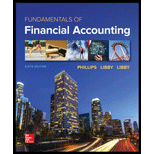
1.
Identify whether Company NGS was profitable in 2018 or 2017 by using gross profit percentage, return on equity and fixed assets turnover ratio.
1.
Explanation of Solution
Gross Profit Percentage:
Gross profit is the financial ratio that shows the relationship between the gross profit and net sales. It represents gross profit as a percentage of net sales. Gross Profit is the difference between the net sales revenue, and the cost of goods sold. It can be calculated by dividing gross profit and net sales.
Identify whether Company NGS was profitable in 2018 or 2017 by using gross profit percentage, return on equity and fixed assets turnover ratio.
Return on equity ratio:
Working note (1):
Working note (2):
Fixed Asset turnover:
Fixed asset turnover is a ratio that measures the productive capacity of the fixed assets to generate the sales revenue for the company. Thus, it shows the relationship between the net sales and the average total fixed assets.
Working note (3):
Working note (4):
By comparing the gross profit percentage, return on equity and fixed assets turnover ratio for 2017 and 2018, Company NGS has high gross profit percentage in 2018 for each sales dollar for the balance cover cost except cost of goods sold on 2018. NGS also has high profit percentage in 2018 than 2017 for return on equity and fixed assets turnover. Increase in the return on equity during 2018 reports that company is able to retain its business better than during the year 2017. Increase in the fixed asset turnover during 2018 reports that NGS is well organised to use its assets to generate its sales.
2.
Identify whether Company NGS was liquid in 2018 or 2017 by using
2.
Explanation of Solution
Current ratio:
Current ratio is used to determine the relationship between current assets and current liabilities. The ideal current ratio is 2:1.
Identify whether Company NGS was liquid in 2018 or 2017 by using current ratio.
It is difficult to determine whether Company NGS has more liquidity during 2018 or 2017 because company has sufficient current assets to meet out their current liabilities for every year.
3.
Identify whether Company NGS was liquid in 2018 or 2017 by using debt-to-assets and times interest earned ratio.
3.
Explanation of Solution
Debt to Asset Ratio:
Debt to asset ratio is the ratio between total asset and total liability of the company. Debt ratio reflects the finance strategy of the company. It is used to evaluate company’s ability to pay its debts. Higher debt ratio implies the higher financial risk.
Identify whether Company NGS was liquid in 2018 or 2017 by using debt-to-assets and times interest earned ratio.
Times interest earned ratio:
Times interest earned ratio quantifies the number of times the earnings before interest and taxes can pay the interest expense.
Company NGS has more solvency during the year 2018 than 2017. Because increase in the times interest earned ratio during 2018, shows that the company has sufficient profit during the year 2018 to cover its interest. Decrease in the debt-to-assets ratio during 2018 than 2017, shows that company has reduced its financial risk level in the year 2018.
Want to see more full solutions like this?
Chapter 13 Solutions
Fundamentals Of Financial Accounting

 AccountingAccountingISBN:9781337272094Author:WARREN, Carl S., Reeve, James M., Duchac, Jonathan E.Publisher:Cengage Learning,
AccountingAccountingISBN:9781337272094Author:WARREN, Carl S., Reeve, James M., Duchac, Jonathan E.Publisher:Cengage Learning, Accounting Information SystemsAccountingISBN:9781337619202Author:Hall, James A.Publisher:Cengage Learning,
Accounting Information SystemsAccountingISBN:9781337619202Author:Hall, James A.Publisher:Cengage Learning, Horngren's Cost Accounting: A Managerial Emphasis...AccountingISBN:9780134475585Author:Srikant M. Datar, Madhav V. RajanPublisher:PEARSON
Horngren's Cost Accounting: A Managerial Emphasis...AccountingISBN:9780134475585Author:Srikant M. Datar, Madhav V. RajanPublisher:PEARSON Intermediate AccountingAccountingISBN:9781259722660Author:J. David Spiceland, Mark W. Nelson, Wayne M ThomasPublisher:McGraw-Hill Education
Intermediate AccountingAccountingISBN:9781259722660Author:J. David Spiceland, Mark W. Nelson, Wayne M ThomasPublisher:McGraw-Hill Education Financial and Managerial AccountingAccountingISBN:9781259726705Author:John J Wild, Ken W. Shaw, Barbara Chiappetta Fundamental Accounting PrinciplesPublisher:McGraw-Hill Education
Financial and Managerial AccountingAccountingISBN:9781259726705Author:John J Wild, Ken W. Shaw, Barbara Chiappetta Fundamental Accounting PrinciplesPublisher:McGraw-Hill Education





